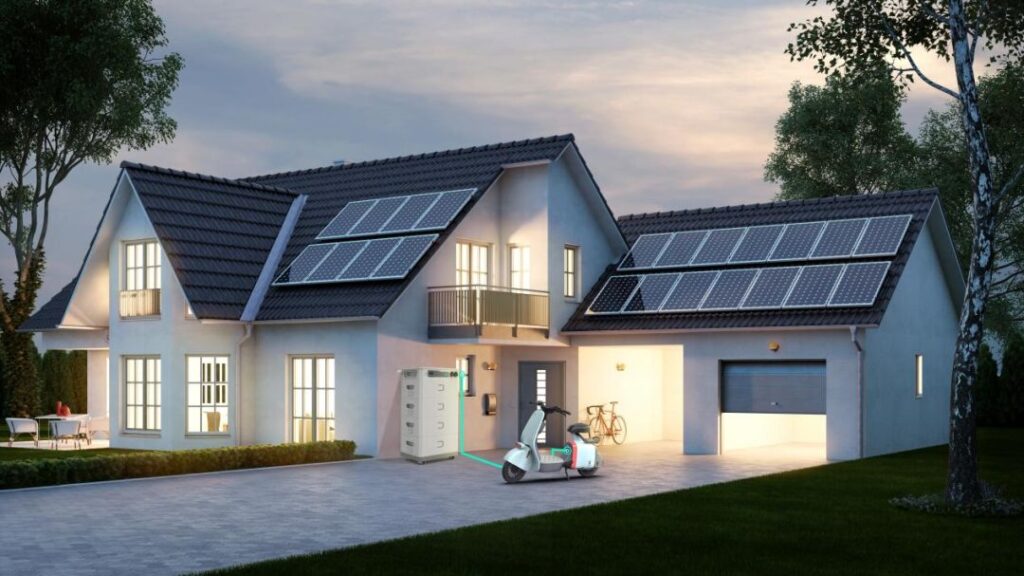When investing in Balcony Energy Storage Systems (BESS), understanding their lifespan is crucial for making informed decisions. Whether for residential or commercial use, businesses and consumers want assurances that energy storage systems will provide long-term value, reliability, and performance. Several factors influence the longevity of these systems, and in this article, we will explore the key variables that determine their lifespan.
This blog will dive into the science of battery life, the impact of environmental factors, and maintenance requirements. We will offer a clear understanding of what users can expect in terms of performance over time and how to maximize the life of balcony energy storage systems.
1. Defining the Lifespan of Balcony Energy Storage Systems
The lifespan of a balcony energy storage system is typically measured in terms of battery life—specifically, the number of complete charge-discharge cycles the battery can undergo before its capacity significantly degrades. Battery capacity decreases over time, meaning that after a certain point, the energy storage system will hold less charge than when it was new.
What is a Charge-Discharge Cycle?
A charge-discharge cycle refers to one complete round of fully charging the battery and then discharging it. For example, if you store energy during the day from a solar panel and use it at night, that counts as one cycle. A battery’s lifespan is often quoted in terms of how many cycles it can endure before its capacity drops to a certain percentage, typically 80% of its original capacity.
Expected Lifespan in Years
On average, the lifespan of modern balcony energy storage systems is between 10-15 years, depending on various factors such as usage patterns, maintenance, and environmental conditions. However, some systems may last longer with proper care, while others may degrade more quickly if exposed to unfavorable conditions.

2. Key Factors Affecting the Lifespan of Balcony Energy Storage Systems
Several factors can influence the lifespan of a balcony energy storage system, and understanding these factors can help users maximize their system’s performance and longevity.
1. Battery Chemistry
The type of battery chemistry used in balcony energy storage systems plays a significant role in determining their lifespan. The most common types of batteries used in these systems are lithium-ion and lead-acid batteries, both of which have different lifespans and characteristics.
Lithium-Ion Batteries
- Lifespan: Typically, lithium-ion batteries have a lifespan of between 3,000 to 6,000 charge-discharge cycles, which translates to 10-15 years of use under normal conditions.
- Advantages: Lithium-ion batteries are known for their high energy density and long cycle life, making them ideal for balcony energy storage systems.
- Degradation: Over time, lithium-ion batteries lose capacity, but they generally degrade at a slower rate compared to other battery chemistries.
Lead-Acid Batteries
- Lifespan: Lead-acid batteries have a shorter lifespan of around 500 to 1,200 cycles, which generally equates to 3-5 years of use.
- Advantages: Lead-acid batteries are more affordable upfront but come with a shorter lifespan and lower energy density compared to lithium-ion batteries.
- Degradation: Lead-acid batteries degrade more quickly, especially if not properly maintained.
2. Depth of Discharge (DoD)
Depth of Discharge (DoD) refers to how much of the battery’s capacity is used during each charge-discharge cycle. For instance, a 100% DoD means the battery is fully discharged, while a 50% DoD means only half of the battery’s capacity is used before recharging.
- Impact on Lifespan: Batteries that are regularly discharged to their full capacity (100% DoD) tend to have a shorter lifespan compared to those that are only partially discharged (e.g., 50% DoD). For example, a lithium-ion battery that is only discharged to 50% of its capacity may last significantly longer than one that is discharged to 100% each time.
3. Environmental Conditions
Temperature plays a critical role in the longevity of balcony energy storage systems, particularly for batteries. Both extreme heat and extreme cold can shorten the lifespan of the battery, affecting its performance and safety.
- Optimal Temperatures: Most energy storage systems are designed to operate optimally between 15°C (59°F) and 30°C (86°F).
- Impact of High Temperatures: Exposure to high temperatures can cause the battery to overheat, leading to faster degradation and a shorter lifespan.
- Impact of Low Temperatures: Extremely cold temperatures can reduce the battery’s efficiency and slow down chemical reactions, leading to reduced capacity and performance.
Weatherproofing
Since balcony energy storage systems are often installed in outdoor environments, they need to be weatherproof and capable of withstanding rain, snow, and UV exposure. Systems with higher IP (Ingress Protection) ratings can better resist environmental damage and last longer.
4. Charging and Discharging Rates
The rate at which a battery is charged and discharged also affects its lifespan. Fast charging can generate more heat, which can degrade the battery over time. Similarly, consistently drawing high levels of power from the battery can shorten its lifespan.
- Slow Charging: Charging at a slower rate generates less heat, which can extend the life of the battery.
- Peak Power Draw: Drawing lower amounts of power over longer periods helps preserve the battery’s capacity and prolong its life.
5. Maintenance and Monitoring
Proper maintenance and regular monitoring are essential for extending the lifespan of balcony energy storage systems. Here’s a list of best practices that can significantly impact the longevity of the system:
- Regular Inspections: Periodically check the system for any signs of wear and tear, such as corrosion or damage to the battery casing.
- Firmware Updates: Ensure that the system’s software is up to date. Manufacturers often release updates that optimize battery performance and safety.
- Battery Health Monitoring: Many modern systems come with built-in monitoring tools that allow users to track battery health over time. Early detection of issues can prevent long-term damage.
3. Expected Lifespan Based on Usage Patterns
The usage patterns of the balcony energy storage system directly impact how long the system will last. Frequent cycling, extreme depths of discharge, and exposure to harsh environmental conditions can all reduce the system’s overall lifespan.
Estimated Lifespan Based on Usage Scenarios
| Usage Scenario | Expected Lifespan (Years) | Cycle Count | Notes |
|---|---|---|---|
| Light Usage (50% DoD, 1 cycle/day) | 12-15 years | 4,500 – 6,000 cycles | Ideal for households using energy primarily during peak hours and storing energy during off-peak or solar surplus. |
| Moderate Usage (80% DoD, 1 cycle/day) | 8-12 years | 3,000 – 4,500 cycles | Moderate usage patterns, such as homes with higher energy consumption or a focus on self-sufficiency. |
| Heavy Usage (100% DoD, 2 cycles/day) | 5-7 years | 1,500 – 3,000 cycles | For households or businesses with consistently high energy demand, cycling the battery multiple times per day. |
| Extreme Conditions (100% DoD, 2+ cycles/day, high temp) | 3-5 years | 1,000 – 1,500 cycles | Usage in extreme environments or with aggressive cycling patterns can significantly shorten the lifespan due to accelerated battery degradation. |
4. How to Extend the Lifespan of Balcony Energy Storage Systems
Even though energy storage systems have a finite lifespan, there are several strategies to maximize their longevity and performance. By following these tips, users can ensure they get the most out of their system investment.
1. Optimize Depth of Discharge
One of the simplest ways to extend the life of a balcony energy storage system is to limit the Depth of Discharge (DoD). Keeping the DoD below 80% can significantly extend the lifetime of the battery.
- Set Charging Limits: Many systems allow users to set limits on how much the battery discharges. For example, setting a maximum DoD of 50% can double the number of charge-discharge cycles the battery can endure.
2. Maintain Ideal Operating Temperatures
Ensure that the balcony energy storage system is installed in a location where temperature fluctuations are minimized. While most systems are designed to handle outdoor conditions, placing the system in a shaded or insulated area can reduce exposure to extreme temperatures.
- Use Thermal Insulation: For systems installed in areas with extreme temperature variations, thermal insulation can help maintain optimal operating conditions for the battery.
3. Regular Maintenance and Monitoring
Perform routine inspections and system health checks to ensure the system is functioning correctly. Many modern systems come with monitoring tools that allow users to track the health of the battery in real-time.
- Check for Firmware Updates: Manufacturers frequently release firmware updates that optimize the system’s performance and address potential issues.
- Inspect Physical Components: Regularly inspect battery casings, electrical connections, and cooling systems for any signs of damage or wear.
5. The Future of Balcony Energy Storage Lifespans: What’s on the Horizon?
The lifespan of balcony energy storage systems is only expected to improve as battery technology advances. Several key trends are emerging that could significantly extend the longevity and reliability of energy storage systems.
1. Solid-State Batteries
One of the most promising developments in battery technology is the advent of solid-state batteries. These batteries replace the liquid electrolyte found in traditional lithium-ion batteries with a solid electrolyte. This design has several advantages, including:
- Longer Lifespan: Solid-state batteries are less prone to degradation, which could extend their lifespan beyond current lithium-ion batteries.
- Improved Safety: Solid-state batteries are less likely to overheat or suffer from thermal runaway, making them safer for long-term use.
2. AI-Driven Battery Management Systems
Advances in Artificial Intelligence (AI) are enabling smart Battery Management Systems (BMS) that can predict and prevent battery degradation. AI-driven systems can analyze usage patterns and environmental conditions to optimize charging and discharging cycles, extending the life of the battery.
3. Second-Life Battery Applications
As electric vehicles (EVs) become more widespread, second-life batteries from EVs are being repurposed for energy storage systems. While these batteries may no longer be suitable for use in vehicles, they still have significant capacity for use in stationary applications like balcony energy storage systems.

Conclusion: Ensuring Long-Term Value from Balcony Energy Storage Systems
The lifespan of a balcony energy storage system depends on a variety of factors, including battery chemistry, usage patterns, environmental conditions, and maintenance. With proper care, most modern systems can last between 10-15 years, delivering thousands of charge-discharge cycles and substantial energy savings over their lifetime.
By understanding the key factors that affect battery life and following best practices for maintenance and usage, businesses and consumers can maximize the value of their investment in balcony energy storage systems. Moreover, as battery technology continues to evolve with advancements like solid-state batteries and AI-driven management systems, the future of balcony energy storage systems looks brighter than ever.
Whether you’re a business looking to offer these systems to your clients or a consumer considering an investment in energy storage, longevity is key to ensuring a solid return on investment—and with the right strategies, balcony energy storage systems can provide reliable, long-term performance.





